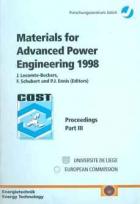
Report on Short-term Scientific Missions 1997-98

Materials for Advanced Power Engineering 1998 - Proceedings Part III

Ecological Aspects of Denitrification, with Emphasis on Agriculture - Management Committee Meeting and Workshop March 9-11 2006

76 Eurosilva - Contribution to the Forest Tree Physiology

Phosphorus Compounds: Advanced Tools in Catalysis and Material Sciences
- Author(s): M. Peruzzini and L. Gonsalvi (Eds)
- Publisher(s): Springer
- http://www.springer.com/series/5763
- ISBN/ISSN: 978-90-481-3816-6
Each chapter of Phosphorus Compounds: Advanced Tools in Catalysis and Material Sciences has been carefully selected by the editors in order to represent a state-of-the-art overview of how phosphorus chemistry can provide solutions in various fields of applications.
The editors have assembled an international array of world-renowned scientists and each chapter is written by experts in the fields of synthetic chemistry, homogeneous catalysis, dendrimers, theoretical calculations, materials science, and medicinal chemistry with a special focus on the chemistry of phosphorus compounds.
This book series covers topics of interest to a wide range of academic and industrial chemists, and biochemists. Catalysis by metal complexes plays a prominent role in many processes. Developments in analytical and synthetic techniques and instrumentation, particularly over the last 30 years, have resulted in an increasingly sophisticated understanding of catalytic processes.
Industrial applications include the production of petrochemicals, fine chemicals and pharmaceuticals (particularly through asymmetric catalysis), hydrometallurgy, and waste-treatment processes. Many life processes are based on metallo-enzyme systems that catalyze redox and acid-base reactions.
Catalysis by metal complexes is an exciting, fast developing and challenging interdisciplinary topic which spans and embraces the three areas of catalysis: heterogeneous, homogeneous, and metallo-enzyme.
Catalysis by Metal Complexes deals with all aspects of catalysis which involve metal complexes and seeks to publish authoritative, state-of-the-art volumes which serve to document the progress being made in this interdisciplinary area of science.
Phosphorus Compounds: Advanced Tools in Catalysis and Material Sciences is of interest to a general leadership ranging from advanced university course students to experts in academia and chemistry.

Innovative production technologies and increased wood products recycling and reuse - proceedings of the second international conference of COST Action FP1407
- Author(s): Kutnar, A., Schwarzkopf, M., Burnard, M., Sebera, V., Troppová, E.
- Publisher(s): Mendel University, Brno, Czech Republic
- Download PDF
- ISBN/ISSN: 978-80-7509-429-2 |
The second international conference organised by
focused on innovation and the environmental aspects of using wood and wood products, presenting state-of-the-art production technologies in wood modification, as well as the development of recycling technologies and systems for modified wood and related barriers and challenges.

Interplay between Usability Evaluation and Software Development
- Pages: 81
- Author(s): S. Abrahão, E. Lai-Chong Law, J. Stage, K. Hornbæk, N. Juristo
- Publisher(s): Audio Visual Services, University of Leicester
- Download from external website
Proceedings of the workshop held on 24 September 2008 in Pisa, Italy.

Strategies for a Low Carbon Urban Built Environment
- Author(s): Vincent Buhagiar (Ed)
- ISBN/ISSN: 978-99932-7-293-9
This publication is the outcome from the mid-term conference held in Munich on 24 – 25 September 2008.

Review of Applied-Statistical Methods For Flood-Frequency Analysis in Europe
- Author(s): Castellarin, A. et al. (Eds)
- Publisher(s): The Centre for Ecology & Hydrology
- Download PDF
- ISBN/ISSN: 978-1-906698-32-4
Flood frequency analysis is used for establishing a relationship between flood magnitude and frequency of occurrence (return period) and for estimating the design-flood at a given
location of interest. The approach can be implemented locally (At-Site Flood Frequency
Analysis, SFFA); or regionally (Regional Flood Frequency Analysis, RFFA), which is used to limit unreliable extrapolation when available data record lengths are short as compared to the recurrence interval of interest, or for predicting the flooding potential at locations where no observed data are available. Both SFFA and RFFA are mature disciplines and consolidated methodologies are available for many European regions. As a result, different European countries, and sometimes even different regions within a country, have adopted different methodologies, which are often selected on the basis of traditional approaches or restricted due to limitation of available data.
The main objective of the COST Action ES0901 European procedure for flood frequency
estimation (FloodFreq, http://www.cost-floodfreq.eu/), which started in 2010, is to undertake a pan-European comparison and evaluation of methods for flood frequency estimation under the various climatologic and geographic conditions found in Europe, and different levels of data availability, as required by European Flood Directive (2007/60/EC). In particular, Working Group 2 (WG2) is focusing on an assessment of statistical methods for flood frequency estimation. In the first phase of WG2, state-of-the-art methods were collected from all member countries of the WGs, and presented in a report form.
In this report, the description of applied frequency analysis methods is presented. The report also include a catalogue of flood data availability/unavailability across Europe together with relevant information (e.g., catchment descriptors, climatological [see above] and hydrological characteristics, indications on frequency distribution recommended for use in flood frequency studies) are collected and presented. Finally, this report presents some preliminary outcomes of analyses that aim to identify in an L moment-based framework the most suitable parent distributions for representing the frequency regime of annual maximum flood across Europe.
